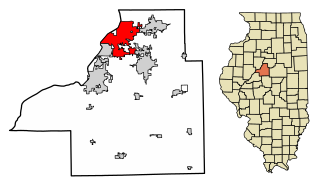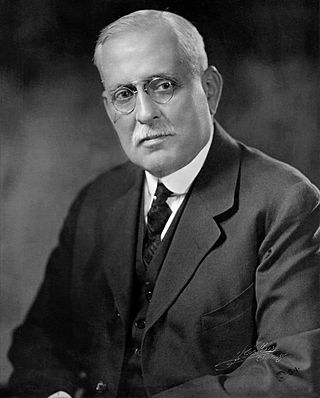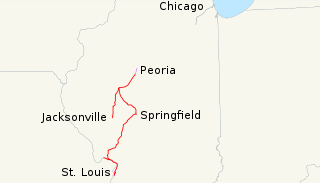
East Peoria is a city in Tazewell County, Illinois, United States. The population was 22,484 at the 2020 census. East Peoria is a suburb of Peoria and is part of the Peoria, Illinois Metropolitan Statistical Area, located across the Illinois River from downtown Peoria. It is home to many Caterpillar Inc. facilities.

Samuel Insull was a British business magnate. He was an innovator and investor based in Chicago who helped create an integrated electrical infrastructure in the United States. Insull created holding companies that purchased utilities and railroads. Insull was responsible for the building of the Chicago Civic Opera House in 1929. Due to the Great Depression, his vast Midwest holding company empire collapsed, and he was accused of profiting personally by selling worthless stock to unsuspecting investors who trusted him because of his position and reputation. Following a seven-week trial, he and 16 co-defendants were acquitted of all charges after two hours of jury deliberation.

Illinois Route 29 is a two to four lane state highway that runs south from U.S. Route 6/Illinois Route 89 at Spring Valley to U.S. Route 51/Illinois Route 16 at Pana, running through Pekin, Peoria and Springfield. The nearest major north–south highway, Interstate 39, runs parallel to Illinois 29, but approximately fifty miles to the east. Illinois 29 is 175.36 miles (282.21 km) long.

The Missouri & Northern Arkansas Railroad, LLC is a Class II Regional Railroad in the U.S. states of Missouri, Kansas, and Arkansas. The company is headquartered in Carthage, Missouri. It is not to be confused with the Missouri and North Arkansas Railroad which connected Joplin, Missouri, with Helena, Arkansas, from 1906 to 1946.

The Commonwealth Railway, Inc. is a United States Class III short-line railroad operating 27 miles (43 km) of track of a former Norfolk, Franklin and Danville Railway line from Suffolk, Virginia, to Portsmouth, Virginia. The main office is in the Wilroy area of Suffolk. Commonwealth Railway was acquired by Genesee & Wyoming Inc. in 1996 and is a part of Norfolk Southern's "Thoroughbred Shortline Program". It interchanges with Norfolk Southern and CSX in Norfolk, Virginia.

The Toledo, Peoria and Western Railway is a short line railroad that operates 247 miles (398 km) of track from Mapleton, Illinois, through Peoria across Illinois to Logansport, Indiana. TP&W has trackage rights between Galesburg, Illinois, and Peoria, between Logansport and Kokomo, Indiana, and between Reynolds, Indiana, and Lafayette, Indiana. TPW has connections with UP, BNSF, NS, CSXT, CN, CP, BL, CERA, CIM, KBSR and T&P. The railroad is now owned by Genesee & Wyoming Inc. The railroad's traffic comes largely from agricultural products, including both raw and processed grain products, as well as chemicals and completed tractors. The TPW hauled around 26,000 carloads in 2008.

The Tazewell & Peoria Railroad (T&P) is a short-line railroad, running entirely in Peoria County and Tazewell County, Illinois, and formed by Genesee & Wyoming Inc. to lease the assets of the century-old Peoria and Pekin Union Railway (P&PU), which is owned by Union Pacific, Norfolk Southern and Canadian National. It switches close to 100,000 cars per year and has about 142 miles of track. Genesee & Wyoming owns 81 miles of TZPR and can handle freight cars with up to 286,000 pounds of cargo.

Springfield Union Station in Springfield, Illinois, is a former train station and now part of the complex of buildings that together form the Abraham Lincoln Presidential Library and Museum. It is listed on the National Register of Historic Places, and is located at 500 East Madison Street in downtown Springfield, adjacent to the Lincoln Presidential Library.

The Indiana Southern Railroad is a Class III, short line railroad operating in the United States state of Indiana. It began operations in 1992 as a RailTex property and was acquired by RailAmerica in 2000. RailAmerica was itself acquired by Genesee & Wyoming in December 2012.

The Indiana & Ohio Railway is an American railroad that operates 570 miles (920 km) of track in Ohio, southern Michigan, and parts of southeastern Indiana. It is owned and operated by Genesee & Wyoming, who acquired the railroad in the 2012 purchase of RailAmerica.

The Chicago, Ft. Wayne & Eastern Railroad is a short line railroad offering service from Tolleston, Indiana to Crestline, Ohio, United States over the former Fort Wayne Line of the Pennsylvania Railroad. It began operations in 2004 as a division of the Central Railroad of Indianapolis (CERA), under the overall corporate ownership of RailAmerica. CFE operates 273 miles (439 km) of rail leased from CSX.

The Chicago, Peoria and St. Louis Railroad (CP&StL) was a railroad in the U.S. state of Illinois that operated a main line between Pekin and Madison via Springfield. Its property was sold at foreclosure to several new companies in the 1920s; the portion north of Springfield has since become the Illinois and Midland Railroad, while the remainder has been abandoned, except for a portion near St. Louis that is now owned by the Norfolk Southern Railway.
The Chicago and St. Louis Railway was a predecessor of the Atchison, Topeka and Santa Fe Railway that owned a line between Chicago and Pekin, Illinois. More than half of the line is now part of the BNSF Railway's Southern Transcon.

The Tomahawk Railway is the trade name employed by Genesee & Wyoming to operate 8 miles (13 km) of railroad in northern Wisconsin.

The St. Louis, Peoria and Northern Railroad Depot, previously known as the Pekin Depot or Chicago and Alton Depot, is a historic railroad station in Pekin, Illinois. The station is one of the only historic rail-related buildings remaining in Pekin.

Peoria Union Station was a passenger rail hub for north-central Illinois, in Peoria, Illinois. Built in the Second Empire architecture style, it was located on Depot Street, between State and Oak Streets, near the Illinois River. At its peak, it had seven tracks operating. However, even by World War II, it was only a junction point for regional lines that seldom extended beyond the state of Illinois. This station, the Rock Island Depot and the Illinois Terminal reached their peak volume of trains in 1920 with 110 trains running in and out daily.
The Chicago and Illinois Western Railroad was an industrial switching railroad serving the west side of Chicago and southwest Cook County. From a connection with a now defunct north–south railroad line near 31st Blvd. and Western Ave. it went west along 33rd St. to Cicero. Just before Cicero Ave. it turned south and roughly paralleled Cicero Ave. to the Chicago Sanitary and Ship Canal. At the canal it turned west and paralleled the canal and then the Des Plaines River to Hodgkins. Incorporated in 1903, it was merged into the Illinois Central Gulf Railroad in 1984. In 2020 a short segment is used by the Canadian National Railway and the Cicero Central Railroad.
















